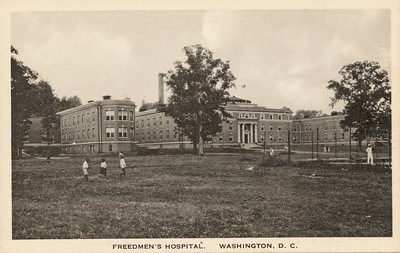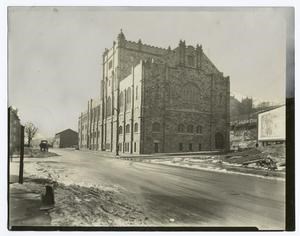Part of a series of articles titled Curiosity Kit: Mabel Keaton Staupers.
Article
Places of Mabel Keaton Staupers

FREEDMEN'S HOSPITAL SCHOOL OF NURSING IMAGES COLLECTION. Moreland-Springarn Research Center, Howard University.
Mabel Keaton Staupers fought for equal opportunities for African American nurses.
Staupers was born in Barbados in 1890 and moved to Harlem in New York City when she was thirteen. In 1917, Staupers graduated with honors from Freedmen’s Hospital School of Nursing in Washington DC. Returning to Harlem, she helped found the Booker T. Washington Sanitarium with Black doctors Louis T. Wright and James Wilson. It was one of the few hospitals in Harlem, a mostly African American neighborhood, that treated Black patients. Staupers also served on the Harlem chapter of the New York Tuberculosis and Health Committee. She dedicated her work in New York to helping the Black community.
In 1934, Staupers was appointed Executive Secretary of the National Association of Graduate Colored Nurses (NAGCN). She was the first person paid to hold the position. As Executive Secretary, Staupers spent over a decade advocating for Black nurses in white organizations, like the American Nurses Association (ANA), that did not welcome or protect them. During World War II, she led a campaign to integrate the Army Nurse Corps. To achieve this goal, she met with Eleanor Roosevelt and organized a national letter-writing campaign. In 1943, she testified before Congress in favor of the Cadet Nurse Corps (CNC). She reminded the committee to include protections for minority nurses.
Staupers’ persistence paid off. In January 1945, the Army and Navy accepted all qualified nurses, regardless of race. Her success also led to the integration of the ANA in 1948. In 1951, the NAACP awarded Staupers the Spingarn Medal for her work to desegregate nursing. Staupers wrote a history of the movement, No Time for Prejudice: The Story of the Integration of Negroes in Nursing in the United States in 1961. She continued to practice nursing. Mabel Keaton Staupers died in Washington DC in 1989.

Created using Google My Maps. CROIE Team.

Streets of Washington. Flickr. Posted November 2020.
1. Freedmen’s Hospital School of Nursing, Washington DC
Mabel Keaton Staupers enrolled in Freedmen’s Hospital School of Nursing in 1914. She was in one of the first classes to attend class in their new building on Bryant Street in Washington DC. Freedmen’s Hospital, run by prominent Black doctors, was founded in 1863 to serve the growing free African American population. After the Civil War, Howard University acquired the hospital with the help of the US government. The Nurse Training Program started in 1894 and accepted its first official class in 1896.
When Staupers attended Freedmen’s Hospital School of Nursing, coursework lasted 36 months. Young Black women took courses in biology, infectious diseases, diet, and sanitation. While they trained, they supported the work at Freedman’s Hospital and helped to save lives [1]. At Freedmen’s Hospital, Staupers was trained to believe in the potential of Black nurses and the importance of treating members of the African American community. She earned her RN degree in 1917 and returned to New York City.
Howard University rebuilt its Medical School on a different site, but the 1909 building on Bryant Street now houses the Howard University Cathy Hughes School of Communication. The site is part of the African American Heritage Trail marked by Cultural Tourism DC. Nearby parts of the campus make up the Howard University Historic District, a National Historic Landmark designated in 2001.
2. The Henry Phipps Institute, Philadelphia PA
In Mabel Keaton Staupers’ early career, she worked to get better treatment and care for Black Tuberculosis (TB) patients. In the 19th and early 20th centuries, TB was a major cause of death in Europe and the United States. It impacted up to 90% of urban populations [2]. By the late 19th century, doctors started to treat TB in sanatoriums (sometimes spelled “sanatarium”), which were special facilities that isolated patients and provided cleaner climates believed to promote recovery. This treatment was not affordable for many urban African Americans because of segregation and the costs of travel to these locations. Staupers co-founded one of the first Black sanatoriums in Harlem, the Booker T. Washington Sanitarium.
In 1922, Mabel Staupers moved from New York to Philadelphia on a fellowship for the Henry Phipps Institute. The white philanthropist Henry Phipps Jr. founded the Phipps Institute in 1903. It was a pioneering research facility; one of the first to use X-rays to diagnose TB. The Phipps Institute ran a hospital that trained Black doctors and nurses to help stop the spread of TB in African American communities. Staupers spent two years at the Henry Phipps Institute before returning to New York City. She continued to practice community nursing. She also served on the Harlem Committee of the New York Tuberculosis and Health Association, an organization that worked to duplicate the Phipps’s methods of diagnosis and treatment.
The University of Pennsylvania took over the Phipps Institute in 1910. They moved it to a new building at the corner of Seventh Street and Lombardi Street, across the street from Mother Bethel AME Church. Mother Bethel AME Church is the oldest piece of land continuously owned by African Americans and is a pillar of Philadelphia’s Black community. This location put the Phipps Institute at the heart of the Black community, like Stauper's Booker T. Washington Sanitarium in Harlem. Mother Bethel AME Church is on the National Register of Historic Places. The University of Pennsylvania has since moved all their medical research centers to the west side of Philadelphia.

“The First Convention of the National Association of Colored Graduate Nurses.” New York Public Library, 1909.
3. & 4. National Association of Colored Graduate Nurses Headquarters, New York City
The National Association of Colored Graduate Nurses (NACGN) was formed in 1908 in response to Black nurses' segregated training and working conditions. A contributing factor was their exclusion from the American Nurses Association (ANA). The ANA accepted African American nurses on paper but refused to support them in state chapters that were segregated. Led by Martha Minerva Franklin of Connecticut, a group of 53 Black nurses met at St. Mark’s Methodist Church in Harlem to set the organization's goals. While the group filled an important role in the Black community, membership was low through the 1910s and 1920s.
In 1934, with the support of other Black organizations and private philanthropists, the NACGN wanted to build up the organization. They elected Estelle Massey Riddle Osborne as the President. Members also chose Mabel Staupers as the first paid Executive Secretary. The NACGN moved into new headquarters in the extended Rockefeller complex on W. 50th Street. The offices were in the same building as other prominent Black health organizations.
As Executive Secretary, Staupers organized at local and national levels to advocate for Black nurses. During World War II, she started a letter-writing campaign to integrate Army nurses. She testified before Congress supporting the Cadet Nurse Corps program on behalf of the NACGN. The passage of the Bolton Act, which authorized the Cadet Nurse Corps, protected nurses of all ethnicities and races. In 1945, Staupers and the NACGN also helped integrate Black nurses into the Army and Navy Nurse Corps.
After the war, Staupers and the NACGN continued to advocate for ending the segregation of Black nurses. In 1848, the American Nurses Association created a membership system that guaranteed full integration. With this victory, Staupers and Osborne moved to dissolve the NACGN. Their last meeting in 1949 was ceremonially at St. Mark’s Methodist Episcopal Church in Harlem.

The Miriam and Ira D. Wallach Division of Art, Prints and Photographs: Photography Collection, The New York Public Library. "St. Mark's Methodist Episcopal Church, Harlem." The New York Public Library Digital Collections. 1860 - 1920.
3. St Mark’s Methodist Church, Harlem, New York City
St. Mark’s Methodist Church is still open in Harlem today. The church is just one block from St. Nicholas Historic District, often called “Striver’s Row,” a prominent African American neighborhood from the late 19th and early 20th centuries.
4. 50 West 50th Street, Rockfeller Center Complex, New York City
The headquarters of the NACGN starting in 1934 was part of the developing Rockefeller Center Complex, in part because of donation from the Rockefeller Foundation. During the 1930s the building served as the headquarters of several Black health and activist organizations, including the National Tuberculosis Association, The National Health Circle for Colored People and the National Organization for Public Health Nursing among others. Rockefeller Center is on the National Register of Historic Places.

First Negro Nurses Land in England. August 21. Photograph. Retrieved from the Library of Congress, <www.loc.gov/item/98501418/>.
5. Eleanor Roosevelt’s Residence, New York City
Mabel Staupers advocated for Black nurses throughout World War II. At a time when there were nursing shortages in the military and the home front, Black nurses were rejected by quotas and other discriminatory practices. Staupers testified and wrote letters to publications from Virginia to New York. She went to public recruitment meetings, including one at the Hotel Pierre where she interrupted Surgeon General Kirk. In front of the assembled crowd, she announced it was a disgrace to ask for more volunteers when there were hundreds of African American nurses being turned away. [3]
In 1944, Staupers met with First Lady Eleanor Roosevelt in the Roosevelts' Washington Square apartment in New York City. Before her visit, Staupers sent Roosevelt letters from Black nurses. They detailed women's experiences with segregation and discrimination. Roosevelt and Staupers talked for half an hour about the problems plaguing Black nurses and the Army’s unwillingness to use their skills. In her book, No Time for Prejudice, Staupers remembered:
“Mrs. Roosevelt listened and asked the kind of questions that revealed her keen mind and her understanding of the problems. Although she made no promises, the author [Staupers] had the feeling that Negro nurses had found a friend” [4]
As conditions for Black nurses serving in Prisoner of War Camps and other sites improved, Staupers credited Roosevelt’s influence.
Eleanor Roosevelt would live in the Washington Square Apartment during World War II and after her husband’s death in 1945. It was her permanent residence the year she helped draft the Universal Declaration of Human Rights in 1948. This was the same year Staupers succeeded in integrating the American Nursing Association. Roosevelt’s Apartment building between Washington Square West and Waverly Place is in the Greenwich Village Historic District.
This article was researched and written by Alison Russell, Educator and Consulting Historian with the Cultural Resource Office of Education and Interpretation. It was funded by the National Council on Public History's cooperative agreement wtih the NPS.
[1] “History of the Freedmen’s Hospital School of Nursing.” Howard University, 1974.13. https://core.ac.uk/download/pdf/234740283.pdf
[2] “TUBERCULOSIS IN EUROPE AND NORTH AMERICA, 1800-1922” Harvard Library. https://curiosity.lib.harvard.edu/contagion/feature/tuberculosis-in-europe-and-north-america-1800-1922
[3] Darlen Clark Hine. Black Women in White: Racial Conflict and Cooperation in the Nursing Profession, 1890-1950. Indiana University Press, 1989.
[4] Mabel Keaton Staupers. No Time for Prejudice: A Story of the Integration of Negroes in Nursing in the United States. New York: The MacMillan Company, 1961. 116.
Hine, Darlene Clark. Black Women in White: Racial Conflict and Cooperation in the Nursing Profession, 1890-1950. Indiana University Press, 1989.
“Historic Medical Sites Near Washington DC.” National Library of Medicine, National Institute of Health. August 2022. Historic Medical Sites Near Washington DC - National Library of Medicine (nih.gov)
Hunchak, Paul. “Phipps Family History: The Henry Phipps Institute.” Old Westbury Gardens, 2021. https://www.oldwestburygardens.org/henry-phipps-institute#:~:text=Henry's%201909%20gift%20also%20went,African%2DAmerican%20community%20in%20Philadelphia.
Lustbader, Ken. “Eleanor Roosevelt Residence.” NYC LGBT Historic Site Project, 2017. Eleanor Roosevelt Residence – NYC LGBT Historic Sites Project (nyclgbtsites.org)
“Mabel Keaton Staupers | African American Nurse, Civil Rights Activist & Executive” Encyclopedia Britannica, 1998. https://www.britannica.com/biography/Mabel-Keaton-Staupers/additional-info#history
Leila McNeill. “The Black Nurse Who Drove Integration of the U.S. Nurse Corps.” JSTOR Daily. May 9, 2020. The Black Nurse Who Drove Integration of the U.S. Nurse Corps - JSTOR Daily
Staupers, Mabel K. No Time for Prejudice: A Story of the Integration of Negroes in Nursing in the United States. New York: The MacMillan Company, 1961.
---“Story of the National Association of Colored Graduate Nurses.” The American Journal of Nursing 51, no. 4 (1951): 222–23. https://doi.org/10.2307/3458934.
“Mabel Keaton Staupers, R.N., 1890” Journal of the National Medical Association Mac 1969. 61 (2)
Staten, C. "Mabel Keaton Staupers (1890-1989)." BlackPast.org, 2011. https://www.blackpast.org/african-american-history/staupers-mabel-keaton-1890-1989/
Tags
- african american history
- african american history and culture
- world war ii
- world war 2
- wwii
- ww2
- world war ii home front
- home front
- history of medicine
- civil rights
- nursing
- homefront
- nurse
- army nurse corps
- women's history
- women of public health and history
- women of public health and medicine
- new york
- harlem
- philadelphia
- washington dc
- national register of historic paces
- nrhp
- places of...
- places of article
Last updated: November 6, 2023
